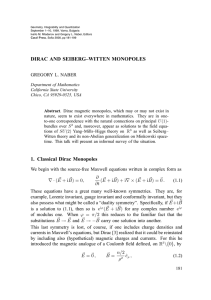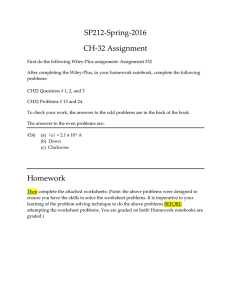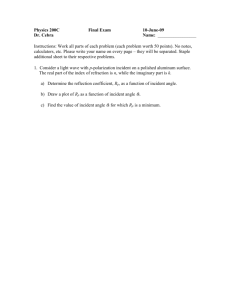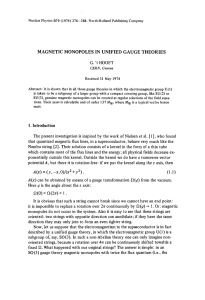200C-FE-S08.doc
advertisement
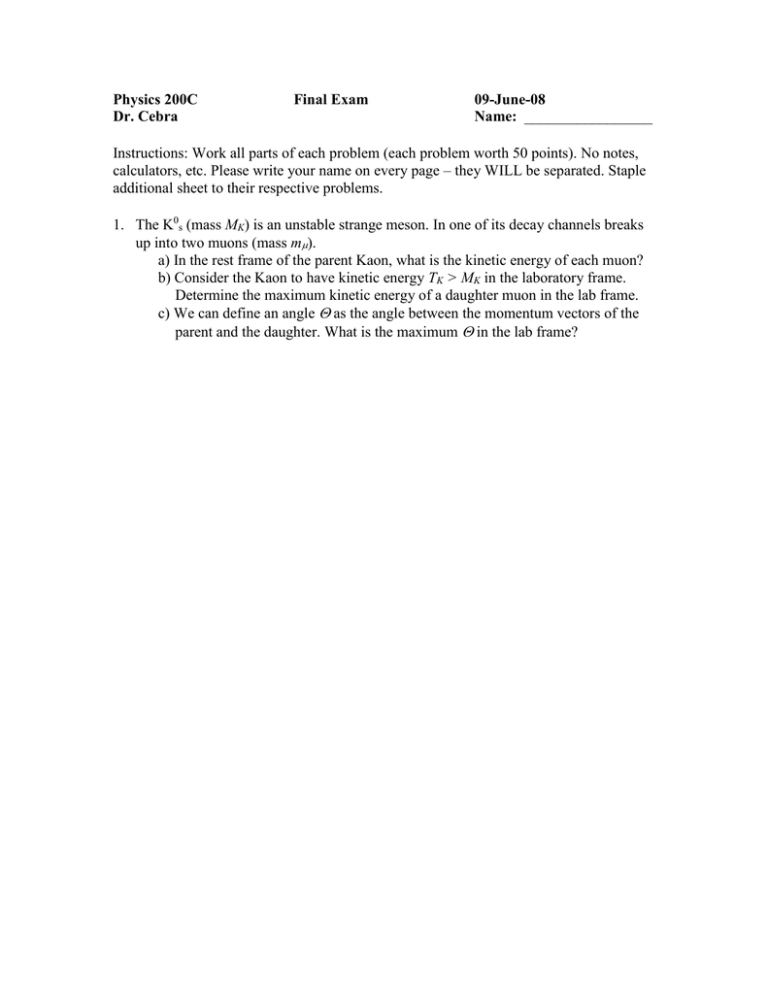
Physics 200C Dr. Cebra Final Exam 09-June-08 Name: _________________ Instructions: Work all parts of each problem (each problem worth 50 points). No notes, calculators, etc. Please write your name on every page – they WILL be separated. Staple additional sheet to their respective problems. 1. The K0s (mass MK) is an unstable strange meson. In one of its decay channels breaks up into two muons (mass m). a) In the rest frame of the parent Kaon, what is the kinetic energy of each muon? b) Consider the Kaon to have kinetic energy TK > MK in the laboratory frame. Determine the maximum kinetic energy of a daughter muon in the lab frame. c) We can define an angle as the angle between the momentum vectors of the parent and the daughter. What is the maximum in the lab frame? Phys 200C Name: _________________ 2. Consider an energetic charged particle with momentum p and mass m. The particle enters a dielectric media (dielectric constant ). The medium is contained within a magnetic field (B), which is perpendicular to the initial trajectory of the incident charged particle. a. Determine the radius of curvature of the trajectory of the charged particle. b. Using the relativistic generalization of the Larmor formula, estimate the energy loss due to synchrotron radiation. c. Assuming that the particle is traveling faster than the speed of light in the medium, estimate the rate of energy loss due to Cherenkov radiation. Phys 200C Name: _________________ 3. Consider a non-conducting medium in the absence of sources: a) Starting from Maxwell’s equations, develop wave equations for the potentials. b) How are these wave equations expressed in covariant notation for the 4potential? c) In linearly dispersive media, and are functions of and complex. From the wave equations for the fields, one can determine the real and imaginary parts of the wave vector k. From plane wave solutions to the wave equation, one can determine the Poynting vector as a function of k and r. Use this to determine the absorption curve as light passes through the medium. Phys 200C Name: _________________ 4. Consider two reference frames K and K’, where the relative velocity between K and K’ is v in the z direction. a) An infinitely long straight wire oriented along the z axis has a charge density . Find the electric and magnetic field in K and K’. b) An infinitely long solenoid has n turns per unit length and carries current I in its rest frame and is oriented along the z axis. What are the electric and magnetic fields in K and K’? c) Demonstrate that JJ is invariant under a Lorentz transformation for both of these configurations. Phys 200C Name: _________________ 5. Although in classical electrodynamics magnetic monopoles are excluded through the equation, there is no fundamental theoretical reason to believe that there should be no monopoles. Indeed the existence of monopoles would solve some theoretical questions. For this question, consider the existence of magnetic monopoles with magnetic change qm and current Jm. a) Write Maxwell’s equations to include magnetic monopoles. b) Maxwell’s equations were developed from empirical observations. Monopoles were excluded because they have never been detected, to date. Suppose a monopole passes through a wire loop with self-inductance L; what current is induced in the loop? c) Consider a relativistic monopole. We have discussed various forms of radiations and energy losses for charged particles. Which is these might produce measurable energy signals in particle detectors? Explain your answer.
